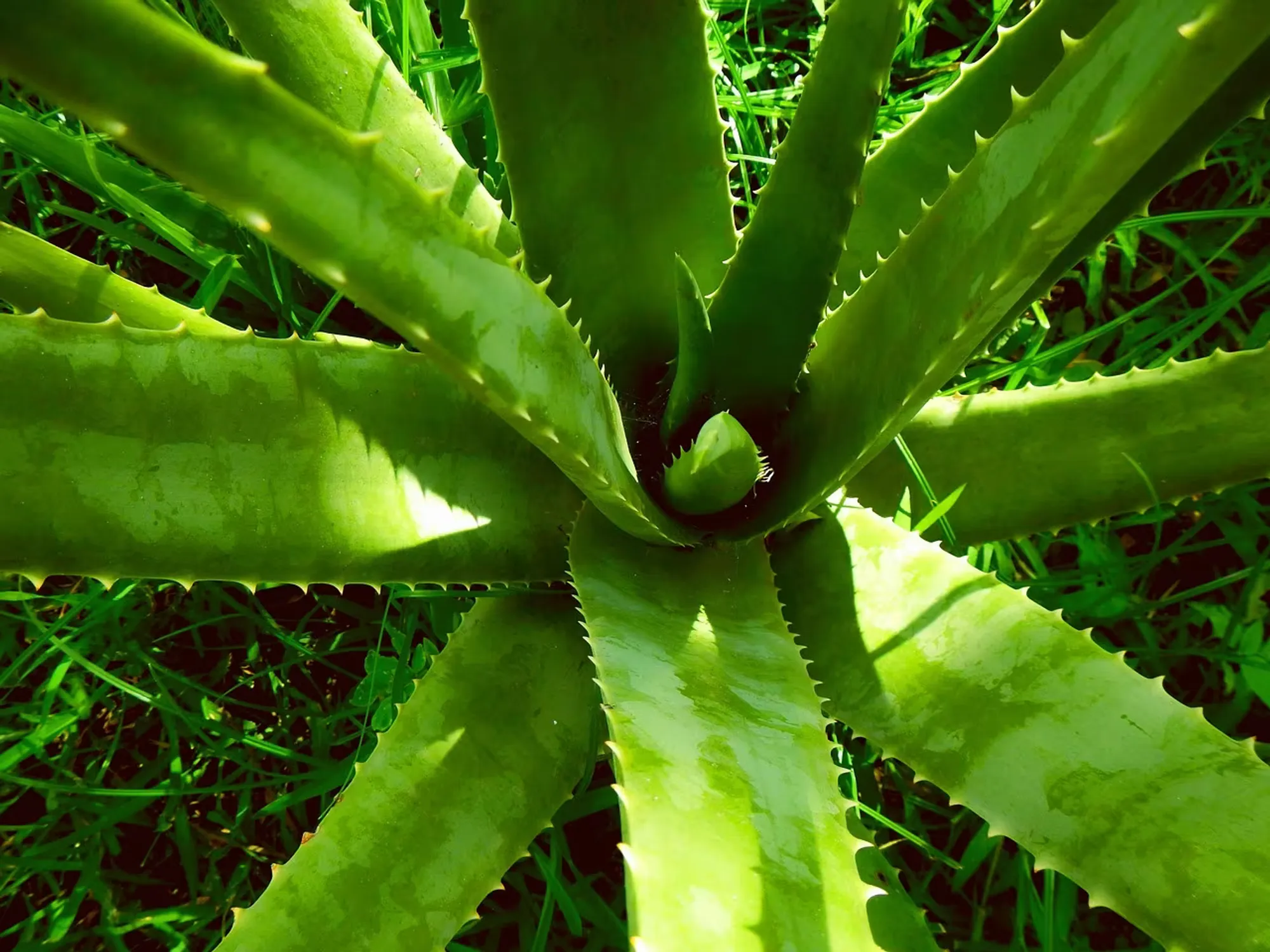
🌿 Quick Summary:
- ☀️ Bright light or partial sun exposure.
- 💧 Water sparingly — let the soil dry out completely between waterings.
- 🌡️ Ideal temperature: 18–30 °C (65–86 °F).
- ✂️ Minimal pruning, remove only damaged leaves.
- 🪴 Repot every 2–3 years in well-draining cactus soil.
🌿 About Aloe vera
Aloe vera is a succulent plant native to Africa and the Arabian Peninsula, widely known for its healing gel rich in vitamins and minerals.
It’s a symbol of health and resilience, often called the “plant of immortality.”
This drought-tolerant species is both decorative and functional, perfect for those seeking a low-maintenance indoor plant with real skin-care benefits.
🌿 Botanical profile
| Feature | Details |
|---|---|
| Scientific name | Aloe vera (syn. Aloe barbadensis miller) |
| Common name | Aloe, Aloe vera |
| Family | Asphodelaceae |
| Origin | Africa, Arabian Peninsula |
| Type | Perennial succulent |
| Mature size | 40–60 cm (16–24 in) |
| Light | Bright light or full indirect sun |
| Watering | Light, let soil dry completely |
| Temperature | 18–30 °C (65–86 °F) |
| Humidity | Low (tolerates dry air) |
| Toxicity | Mildly toxic to pets if ingested |
☀️ Light and placement
Aloe vera loves sunny, warm spots.
Place it near a south- or west-facing window where it can receive several hours of sunlight daily.
💡 Tip: If the leaves stretch or bend, it’s a sign of insufficient light.
Avoid dark corners or excessive shade — light is essential for compact growth and thick, healthy leaves.
💧 Watering and humidity
As a true desert plant, Aloe stores water in its fleshy leaves.
Water every 2–3 weeks in summer, and only once a month in winter.
- Always allow the soil to dry out completely before watering again.
- Use filtered or rainwater at room temperature.
- Empty the saucer after each watering.
🚫 Too much water causes root rot.
💧 Too little water leads to thin, wrinkled leaves — they’ll recover after watering.
💡 Pro tip: When in doubt, don’t water — Aloe prefers dryness to excess moisture.
🌱 Soil and repotting
Ideal mix:
- 60% cactus or succulent soil
- 30% coarse sand or perlite
- 10% fine gravel
This mix ensures excellent drainage and prevents waterlogging.
Repot every 2–3 years, preferably in spring, once roots start filling the pot.
💡 Tip: Add a layer of pebbles or clay balls at the bottom to boost drainage.
🌾 Fertilizing
Aloe vera needs very little fertilizer.
From May to September, feed it once a month with a succulent-specific liquid fertilizer, diluted to half strength.
Avoid fertilizing during the colder months.
🌿 Over-fertilizing can make leaves soft and watery.
✂️ Pruning and maintenance
Pruning is minimal — simply remove dried or damaged leaves near the base.
You can also cut a mature leaf to harvest the gel for external use (on burns or dry skin).
Wipe dust off the leaves occasionally with a soft, damp cloth.
🧤 Caution: Avoid spraying water directly on the leaves; it may cause spots or rot.
🪴 Propagation
Aloe vera reproduces easily through offsets (pups) that grow at the base of the mother plant.
How to propagate:
- Remove a pup about 8–10 cm (3–4 in) tall.
- Let it dry for 24–48 hours so the cut calluses.
- Plant in dry cactus mix.
- Water lightly after one week.
Roots develop within 2–3 weeks in bright, warm conditions.
💡 Tip: Group several young Aloe plants in one pot for a fuller, modern look.
🐛 Common problems and solutions
| Problem | Likely cause | Solution |
|---|---|---|
| Soft or mushy leaves | Overwatering | Let soil dry completely before watering again |
| Brown leaf tips | Sunburn or extreme cold | Move to a bright but sheltered spot |
| Pale, elongated leaves | Insufficient light | Place in brighter light or near a sunny window |
| Black spots at the base | Root rot | Repot in dry, well-draining soil |
🍀 Symbolism and benefits
The Aloe vera symbolizes healing, protection, and renewal.
It’s valued for its medicinal gel, used to soothe burns, hydrate skin, and promote healing.
It’s also an air-purifying plant, helping remove toxins like formaldehyde and benzene from indoor air.
🌿 A perfect mix of beauty and utility — nature’s first-aid plant for your home.
🛠️ Useful accessories
Keep your Aloe healthy with:
(Affiliate links verified by Verdepedia.)
⚠️ Common mistakes
- Watering too often.
- Letting the pot sit in water.
- Keeping in low-light areas.
- Using dense or compact soil.
- Cutting too many leaves at once.
🚨 Quick diagnostic guide
| Symptom | Cause |
|---|---|
| Soft leaves | Overwatering |
| Dry, shriveled leaves | Underwatering |
| Pale, thin leaves | Lack of light |
| Black base | Poor drainage or root rot |
❓ Frequently asked questions
Q: How often should I water my Aloe vera?
A: Every 2–3 weeks in summer, once a month in winter, and only when the soil is completely dry.
Q: Can I use Aloe gel directly on my skin?
A: Yes — it’s soothing and hydrating for minor burns, irritations, or dry skin.
Q: Does Aloe vera like humidity?
A: Not really. It thrives in dry environments with good airflow.
Q: Can Aloe survive outdoors?
A: Yes, in warm climates above 10 °C (50 °F). Protect it from frost and heavy rain.
